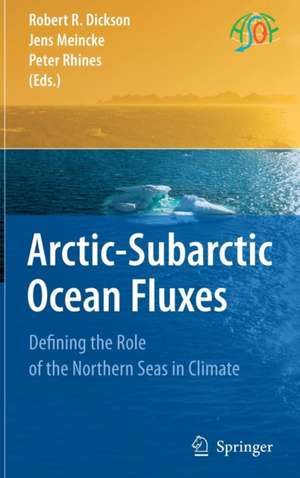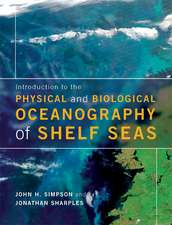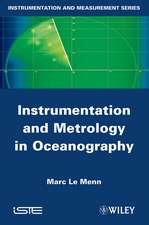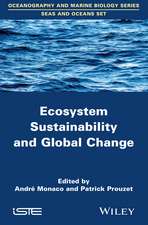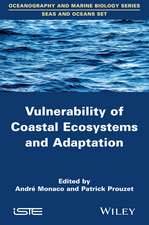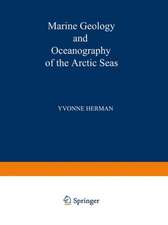Arctic-Subarctic Ocean Fluxes: Defining the Role of the Northern Seas in Climate
Editat de Robert R. Dickson, Jens Meincke, Peter Rhinesen Limba Engleză Hardback – 4 mar 2008
| Toate formatele și edițiile | Preț | Express |
|---|---|---|
| Paperback (1) | 1238.11 lei 6-8 săpt. | |
| SPRINGER NETHERLANDS – 5 noi 2010 | 1238.11 lei 6-8 săpt. | |
| Hardback (1) | 1249.63 lei 6-8 săpt. | |
| SPRINGER NETHERLANDS – 4 mar 2008 | 1249.63 lei 6-8 săpt. |
Preț: 1249.63 lei
Preț vechi: 1523.93 lei
-18% Nou
Puncte Express: 1874
Preț estimativ în valută:
239.13€ • 251.45$ • 197.58£
239.13€ • 251.45$ • 197.58£
Carte tipărită la comandă
Livrare economică 16-30 aprilie
Preluare comenzi: 021 569.72.76
Specificații
ISBN-13: 9781402067730
ISBN-10: 1402067739
Pagini: 736
Ilustrații: X, 736 p.
Dimensiuni: 155 x 235 x 33 mm
Greutate: 1.36 kg
Ediția:2008
Editura: SPRINGER NETHERLANDS
Colecția Springer
Locul publicării:Dordrecht, Netherlands
ISBN-10: 1402067739
Pagini: 736
Ilustrații: X, 736 p.
Dimensiuni: 155 x 235 x 33 mm
Greutate: 1.36 kg
Ediția:2008
Editura: SPRINGER NETHERLANDS
Colecția Springer
Locul publicării:Dordrecht, Netherlands
Public țintă
ResearchCuprins
Arctic–Subarctic Ocean Fluxes: Defining the Role of the Northern Seas in Climate.- The Inflow of Atlantic Water, Heat, and Salt to the Nordic Seas Across the Greenland–Scotland Ridge.- Volume and Heat Transports to the Arctic Ocean Via the Norwegian and Barents Seas.- Variation of Measured Heat Flow Through the Fram Strait Between 1997 and 2006.- Is Oceanic Heat Transport Significant in the Climate System?.- Long-Term Variability of Atlantic Water Inflow to the Northern Seas: Insights from Model Experiments.- Climatic Importance of Large-Scale and Mesoscale Circulation in the Lofoten Basin Deduced from Lagrangian Observations.- Freshwater Storage in the Northern Ocean and the Special Role of the Beaufort Gyre.- Modelling the Sea Ice Export Through Fram Strait.- Fresh-Water Fluxes via Pacific and Arctic Outflows Across the Canadian Polar Shelf.- The Arctic–Subarctic Exchange Through Hudson Strait.- Freshwater Fluxes East of Greenland.- The Changing View on How Freshwater Impacts the Atlantic Meridional Overturning Circulation.- Constraints on Estimating Mass, Heat and Freshwater Transports in the Arctic Ocean: An Exercise.- Variability and Change in the Atmospheric Branch of the Arctic Hydrologic Cycle.- Simulating the Terms in the Arctic Hydrological Budget.- Is the Global Conveyor Belt Threatened by Arctic Ocean Fresh Water Outflow?.- Simulating the Long-Term Variability of Liquid Freshwater Export from the Arctic Ocean.- The Overflow Transport East of Iceland.- The Overflow Flux West of Iceland: Variability, Origins and Forcing.- Tracer Evidence of the Origin and Variability of Denmark Strait Overflow Water.- Transformation and Fate of Overflows in the Northern North Atlantic.- Modelling the Overflows Across the Greenland–Scotland Ridge.- Satellite Evidence ofChange in the Northern Gyre.- The History of the Labrador Sea Water: Production, Spreading, Transformation and Loss.- Convective to Gyre-Scale Dynamics: Seaglider Campaigns in the Labrador Sea 2003–2005.- Convection in the Western North Atlantic Sub-Polar Gyre: Do Small-Scale Wind Events Matter?.- North Atlantic Deep Water Formation in the Labrador Sea, Recirculation Through the Subpolar Gyre, and Discharge to the Subtropics.- Accessing the Inaccessible: Buoyancy-Driven Coastal Currents on the Shelves of Greenland and Eastern Canada.
Textul de pe ultima copertă
The two-way oceanic exchanges that connect the Arctic and Atlantic oceans through subarctic seas are of fundamental importance to climate. Change may certainly be imposed on the Arctic Ocean from subarctic seas, including a changing poleward ocean heat flux that is central to determining the present state and future fate of the perennial sea-ice. And the signal of Arctic change is expected to have its major climatic impact by reaching south through subarctic seas, either side of Greenland, to modulate the Atlantic thermohaline ‘conveyor’. Developing the predictive skills of climate models is seen to be the most direct way of extending the ability of society to mitigate for or adapt to 'global change' and is the main justification for continuing an intense observational effort in these waters. As records have lengthened, they have shown that important aspects of oceanic exchange through subarctic seas are currently at a long-term extreme state, providing further motivation for their study. As one important example, the longest records of all show that the temperature of the main oceanic inflow to the Norwegian Sea along the Scottish shelf and slope, and the temperature of the poleward extension of that flow through the Kola Section of the Barents Sea have never been greater in >100 years. However, we are only now beginning to understand the climatic impact of the remarkable events that are currently in train in subarctic waters, and models remain undecided on some of the most basic issues that link change in our northern seas to climate. Reviewing the achievements of an intense recent observing and modelling effort, this volume intends to assemble the body of evidence that climate models will need if they are one day to make that assessment, quantifying the ocean exchanges through subarctic seas, describing their importance to climate as we currently understand it, explaining their variability, setting out our current ideas on the forcing of these fluxesand our improved capability in modelling the fluxes themselves and the processes at work. Much of that evidence is assembled here for the first time.
Audience:
This book will be of interest to researchers and scientists in oceanographic and climate research institutions, fisheries laboratories, arctic/polar institutions, climate change policy advisors.
Audience:
This book will be of interest to researchers and scientists in oceanographic and climate research institutions, fisheries laboratories, arctic/polar institutions, climate change policy advisors.
Caracteristici
New and unpublished results from the ASOF project First attempt to describe the changing Subarctic Seas as a complete unit Benchmark for the International Polar Year (IPY) and the efforts in understanding Arctic rapid change Editors and leading authors are world experts in the field
